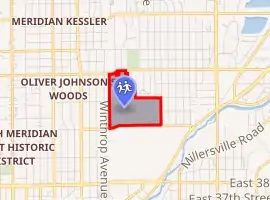Indiana School for the Deaf
Indiana School for the Deaf (ISD) is a fully accredited school for the deaf and hard of hearing, located in Indianapolis, Indiana. It won the best deaf school in America in 2011 and 2014.
| Indiana School for the Deaf | |
|---|---|
 | |
| Address | |

| |
1200 East 42nd Street , 95608 United States | |
| Information | |
| Type | Schools for the Deaf, State school |
| Established | 1843 |
| Superintendent | David Geeslin |
| Director of Instruction | Kim Kause[1] |
| Grades | Pre-K-12 |
| Enrollment | up to 600 (2015) |
| Campus size | ~14 acres |
| Campus type | Suburban |
| Color(s) | Orange and Black |
| Sports | Football, Volleyball, Cross Country, Basketball, Wrestling, Baseball, Softball, Swimming, Track and Field, Cheerleading |
| Mascot | Orioles |
| Athletic Director | Paul Wood[2] |
| Website | deafhoosiers |
Indiana School for the Deaf | |
 Front of the main building | |
   | |
| Location | 1200 E. 42nd St., Indianapolis, Indiana |
|---|---|
| Coordinates | 39°50′6″N 86°8′16″W |
| Area | 14 acres (5.7 ha) |
| Built | 1911 |
| Architect | Rubush & Hunter; Et al. |
| Architectural style | Classical Revival |
| NRHP reference No. | 91000790[3] |
| Added to NRHP | June 27, 1991 |
History

When the first school for the Deaf was established in Indiana, it was named Willard School, after the founder, William Willard.[4]
William Willard was a deaf teacher who taught at Ohio School for the Deaf in Columbus, Ohio. He traveled to Indianapolis in May 1843 to propose the establishment of a Deaf School. Once he had the support of the General Assembly, he recruited approximately twelve students. He and his wife, Eliza, were teachers. Eventually, the school had grown and a law which was passed in January 1846, officially established the Willard School as the sixth state school for the Deaf and the first Deaf school to provide free education to Deaf and hard of hearing students. The school had actually moved a few times in different locations, when finally, the school was built on an 80-acre (32 ha) property on East 42nd Street. The name was changed to Indiana School for the Deaf. The school's main buildings on the current campus were added to the National Register of Historic Places in 1991.[5]
Academics
ISD offers several programs ranging from infants to high school. They are as follows: Parent Infant Program, Preschool, Elementary, Middle School, and High School.
The Parent Infant Program works closely with parents and their deaf or hard of hearing children from ages 0 to 3. When a student reaches 18 months of age, he or she can enroll at ISD as an official student. Preschool handles children up until Pre-Kindergarten. Elementary provides academics and activities for Kindergarten through 4th grade students. Middle school hosts grades 5 to 8, and High School hosts grades 9 through 12.
Residency
ISD is also a residential school. It has dormitories where students reside throughout the week. Students arrive on Sundays and depart on Fridays. Dormitories are for students who live far enough not to be able to travel by bus every day to school. There are dormitories for male and female students: Preschool, Elementary, Middle School, and High School. ISD's residential programs offer extracurricular activities, peer interaction, student growth and development, achievement, and more.
Athletics
ISD offers several athletics starting from 5th grade to 12th grade. There are sports for both female and male students.
- Male Sports
- Football
- Cross Country
- Wrestling
- Basketball
- Baseball
- Track and Field
- Swimming
- Female Sports
- Volleyball
- Basketball
- Cheerleading
- Track and Field
- Swimming
- Softball
See also
- William Willard, founder and first Deaf superintendent of ISD
- Sean Berdy, actor, class of 2011
References
- Deaf Hoosier News, Indianapolis, IN, July 1, 2011. Archived October 25, 2011, at the Wayback Machine
- Deaf Hoosier Sports Poster, Indianapolis, IN, December 11, 2011. Archived February 6, 2012, at the Wayback Machine
- "National Register Information System". National Register of Historic Places. National Park Service. March 13, 2009.
- Gannon, Jack. 1981. Deaf Heritage–A Narrative History of Deaf America, Silver Spring, MD: National Association of the Deaf, p. 23 (PDF Archived March 28, 2012, at the Wayback Machine)
- "Indiana State Historic Architectural and Archaeological Research Database (SHAARD)" (Searchable database). Department of Natural Resources, Division of Historic Preservation and Archaeology. Retrieved August 1, 2016. Note: This includes Jess Smith and Suzanne Rollins (June 1990). "National Register of Historic Places Inventory Nomination Form: Indiana School for the Deaf" (PDF). Retrieved August 1, 2016. and Accompanying photographs
External links
| Wikimedia Commons has media related to Indiana School for the Deaf. |

